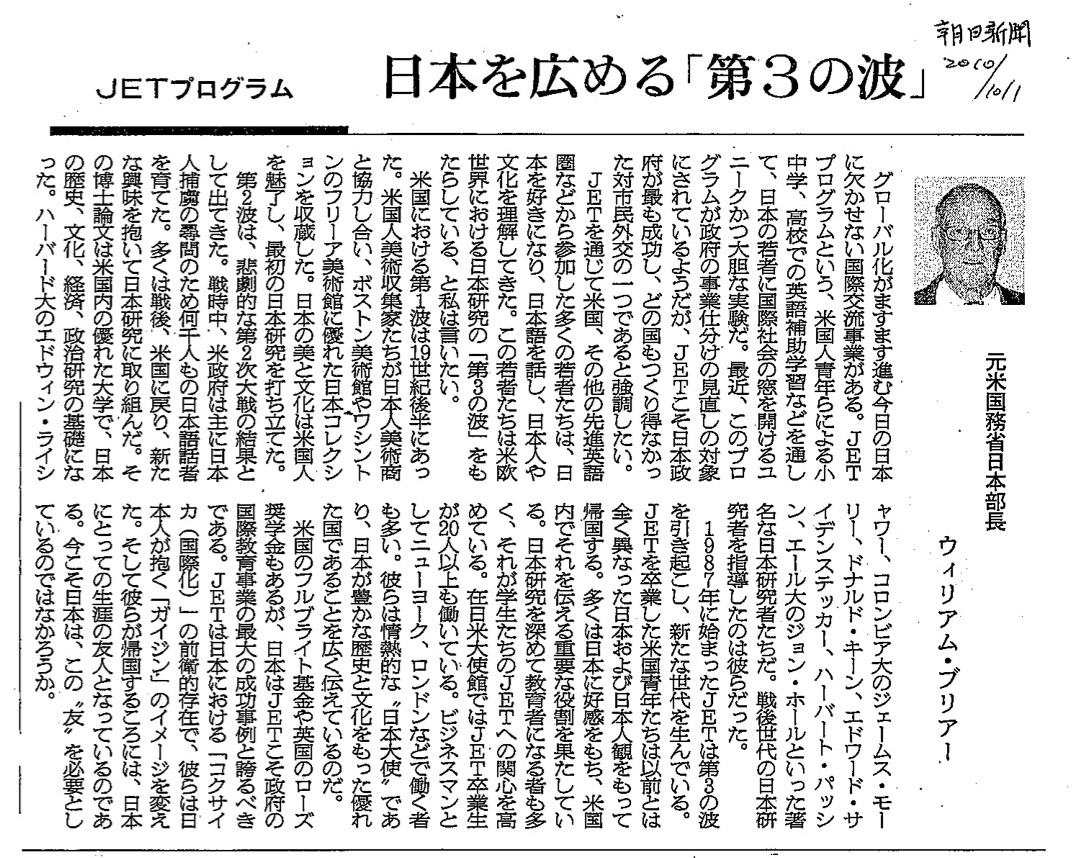Asahi newspaper column offers perspective on the value of JET Programme to Japan
The following is a synopsis/loose translation of Bill Breer’s recent op-ed piece about the importance of the JET Programme to Japan which appeared in the My Viewpoint column of the Asahi newspaper from October 1, 2010. Breer is the former Japan Chair at the Center for Strategic & International Studies.
I thought it was worth sharing with the JET alum community as it provides some rather helpful perspective on the value to Japan of the JET Programme and the JET Alumni Association.
In this world of ongoing globalization, the JET Program is a daring, unique effort to open up the world to students in Japan. It is the Japanese government’s most successful program, and no other country has been able to create a citizens’ exchange initiative like it.
The many young people who have participated in the Program from the world’s leading English-speaking countries have come to like Japan, have learned the language, come to know the people and culture, and have gone on to become the “Third Wave” of Japanese scholarship.
The “First Wave” developed from the mid-19th century as art collectors worked with Japanese artists and merchants to build the great collections at the Boston Museum of Art, the Freer Galleries in Washington, DC, and others, entrancing Americans with Japan’s beauty and culture and producing the first research on Japan.
The “Second Wave” came out of the tragedy of the Second World War, as the US government trained thousands of soldiers in Japanese language for the war effort. These people came home with a deep interest in Japan and created the base of scholarship into Japan’s history, culture, economics and politics at the great universities. These men include Edwin Reischauer at Harvard, James Morley, Donald Keene, Edward Seidensticker and Herbert Passin at Columbia, and John Hall at Yale.
Now, the JET Program, begun in 1987, has given birth to a new generation. These people have an entirely different perspective on Japan and the Japanese people. Many of them have a fondness for Japan and are instrumental in conveying that to people in their home countries. Furthermore, many have gone on to become educators conducting further research on Japan, and this piques their students’ interest in JET. Over 20 ex-JETs work at the US Embassy in Tokyo, and many more work in business in New York, London, and other major cities. They are all passionate “Japanese ambassadors”, conveying the message that Japan is an outstanding country with a rich history and culture.
America has the Fulbright Program and England the Rhodes Scholarships, but Japan should be proud of its JET Program as the most successful example of a government youth exchange program. JET is the advance guard of Japan’s “internationalization”, whose participants have changed the Japanese people’s perceptions of “gaijin” and then gone home to become lifelong friends of Japan.
Japan could still use “friends” like these, couldn’t it?
Here is the original column:




Comments are closed.